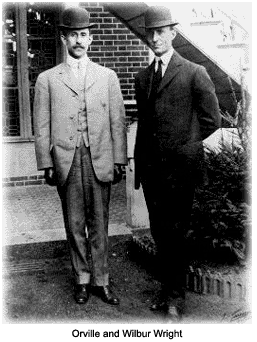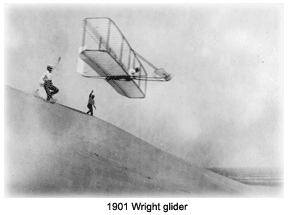 Wilbur and Orville Wright are credited with discovering the principles of human flight. Often called the "Fathers of Powered Flight," their original scientific research and amazing inventions helped to open the era of aviation. The first flight in the Wrights' creation, a manned motor-powered, heavier-than-air craft, took place at Kitty Hawk, North Carolina, on December 17, 1903, with Orville at the controls.
Early days
Wilber and Orville were born to Susan and Milton Wright on April 16, 1867, and August 19, 1871, respectively. Milton was a minister in the Church of the United Brethren in Christ, and had settled his family in Dayton, Ohio, so he could edit the church newspaper published there. In 1878, Milton was elected bishop and moved the family to Iowa. They returned to Dayton in 1885.
Wilbur and Orville’s father brought the boys various souvenirs and trinkets he found during his travels for the church. One toy, a helicopter-like top, sparked the boys' interest in flying.
Wilbur excelled in school, but his family moved just short of his graduation. A head injury from a skating accident, as well as his mother's illness and subsequent death, prevented him from furthering his education.
Orville was an average student, known for his pranks. He quit school before his senior year to start a printing business.
In business
The first time that Wilbur and Orville officially referred to themselves as "The Wright Brothers," was when they established their printing firm at the ages of 22 and 18. Using a damaged tombstone, buggy parts, and mechanical ingenuity, they built a press and printed odd jobs as well as their own newspaper.
In 1893, the brothers opened a bicycle shop. Three years later, they were producing their own brand of bicycle, called Van Cleves and St. Clairs. While only moderately successful as businessmen, the Wrights nevertheless enjoyed modest prosperity between the years 1890 and 1905, and managed to finance flying-machine experiments from their business profits. In 1896, while nursing Orville, sick with typhoid, Wilbur read about the death of a famous German glider pilot. The news led him to take a renewed interest in flying.
Wilbur and Orville Wright are credited with discovering the principles of human flight. Often called the "Fathers of Powered Flight," their original scientific research and amazing inventions helped to open the era of aviation. The first flight in the Wrights' creation, a manned motor-powered, heavier-than-air craft, took place at Kitty Hawk, North Carolina, on December 17, 1903, with Orville at the controls.
Early days
Wilber and Orville were born to Susan and Milton Wright on April 16, 1867, and August 19, 1871, respectively. Milton was a minister in the Church of the United Brethren in Christ, and had settled his family in Dayton, Ohio, so he could edit the church newspaper published there. In 1878, Milton was elected bishop and moved the family to Iowa. They returned to Dayton in 1885.
Wilbur and Orville’s father brought the boys various souvenirs and trinkets he found during his travels for the church. One toy, a helicopter-like top, sparked the boys' interest in flying.
Wilbur excelled in school, but his family moved just short of his graduation. A head injury from a skating accident, as well as his mother's illness and subsequent death, prevented him from furthering his education.
Orville was an average student, known for his pranks. He quit school before his senior year to start a printing business.
In business
The first time that Wilbur and Orville officially referred to themselves as "The Wright Brothers," was when they established their printing firm at the ages of 22 and 18. Using a damaged tombstone, buggy parts, and mechanical ingenuity, they built a press and printed odd jobs as well as their own newspaper.
In 1893, the brothers opened a bicycle shop. Three years later, they were producing their own brand of bicycle, called Van Cleves and St. Clairs. While only moderately successful as businessmen, the Wrights nevertheless enjoyed modest prosperity between the years 1890 and 1905, and managed to finance flying-machine experiments from their business profits. In 1896, while nursing Orville, sick with typhoid, Wilbur read about the death of a famous German glider pilot. The news led him to take a renewed interest in flying.
 Glimmers of flight
On May 30, 1899, Wilber wrote to the Smithsonian Institution for information about aeronautical research. Following a few months of reading all that he could find about flying, he believed he had an answer to the problems that other would-be flyers had faced. In August 1900, using information he had gathered, he built his first glider. After contacting the U.S. Weather Bureau for information on windy regions of the country, Wilbur chose Kitty Hawk, a remote, sandy area off the coast of North Carolina, where winds averaged 13 mph. He and Orville journeyed to Kitty Hawk, where they tested the 1900 glider.
In 1901, following a disappointing performance by one of their glider designs, the Wrights constructed a wind tunnel to test the effectiveness of various wing shapes. In 1902, guided by the results of the wind tunnel experiments, they constructed another glider. The test in October was a success when the glider covered a record 620 feet. The brothers then returned to Dayton, and began work on a propeller and engine for their next effort, a flying machine.
Short but sweet
Having designed a propeller with the same principles they used to design their wings, Wilbur and Orville then built their own four-cylinder, 12-horsepower engine. The 1903 Flyer was built in sections in the back room of their cycle shop, and when complete, it was shipped to Kitty Hawk and assembled. On December 14, 1903 — after winning a coin toss — Wilbur attempted to fly the machine. He stalled it on takeoff, which caused minor damage.
The plane was repaired, and the next attempt was made by Orville on December 17. At 10:35 a.m., he made the first heavier-than-air, machine-powered flight in history. The flight lasted only 12 seconds and covered just 120 feet, but Orville had accomplished what men and women had only dreamed of doing for centuries; he flew.
Back to the drawing board
After their successful first flight, the Wrights returned to Dayton and continued their experiments in relative secrecy for two more years. By the end of 1905, they had transformed the modestly successful machine of 1903 into the world's first practical airplane. They won world fame with their first public demonstration flights in Europe and America, in the summer and fall of 1908.
In 1909, the brothers were welcomed home to Dayton with a two-day gala celebration, at which they received a Congressional gold medal for their work. On September 29, 1909, nearly one million New Yorkers witnessed Wilbur Wright's extraordinary flight above the Hudson River and around the Statue of Liberty, which cemented the Wright Brothers' fame in America.
That year, the brothers founded the Wright Company and won the first U.S. military aviation contract to build a machine that met the following requirements: a two-seater, capable of flights of at least an hour's duration, at an average of 40 mph, and landing undamaged. A reported $30,000 of the federal budget was reserved for military aviation. Also that year, the Wrights built Wright Flyers in factories in Dayton and Germany.
Throughout the years, the Wrights were involved in several patent battles that were ultimately won in 1914.
Closing years
Wilbur died from typhoid fever on May 30, 1912, an event from which Orville never completely recovered. He sold his interests in the airplane company in 1915. Highly respected in aviation circles, he served as a consulting engineer during World War I and was a member of several leading aviation committees, notably the governing boards of both the Daniel and Florence Guggenheim Fund for the Promotion of Aeronautics, and the National Advisory Committee for Aeronautics.
Orville Wright died of a heart attack on January 30, 1948, at his home in Oakwood, Ohio. Both brothers are buried in the family plot at Woodland Cemetery in Dayton, Ohio. Neither brother married or had children.
Glimmers of flight
On May 30, 1899, Wilber wrote to the Smithsonian Institution for information about aeronautical research. Following a few months of reading all that he could find about flying, he believed he had an answer to the problems that other would-be flyers had faced. In August 1900, using information he had gathered, he built his first glider. After contacting the U.S. Weather Bureau for information on windy regions of the country, Wilbur chose Kitty Hawk, a remote, sandy area off the coast of North Carolina, where winds averaged 13 mph. He and Orville journeyed to Kitty Hawk, where they tested the 1900 glider.
In 1901, following a disappointing performance by one of their glider designs, the Wrights constructed a wind tunnel to test the effectiveness of various wing shapes. In 1902, guided by the results of the wind tunnel experiments, they constructed another glider. The test in October was a success when the glider covered a record 620 feet. The brothers then returned to Dayton, and began work on a propeller and engine for their next effort, a flying machine.
Short but sweet
Having designed a propeller with the same principles they used to design their wings, Wilbur and Orville then built their own four-cylinder, 12-horsepower engine. The 1903 Flyer was built in sections in the back room of their cycle shop, and when complete, it was shipped to Kitty Hawk and assembled. On December 14, 1903 — after winning a coin toss — Wilbur attempted to fly the machine. He stalled it on takeoff, which caused minor damage.
The plane was repaired, and the next attempt was made by Orville on December 17. At 10:35 a.m., he made the first heavier-than-air, machine-powered flight in history. The flight lasted only 12 seconds and covered just 120 feet, but Orville had accomplished what men and women had only dreamed of doing for centuries; he flew.
Back to the drawing board
After their successful first flight, the Wrights returned to Dayton and continued their experiments in relative secrecy for two more years. By the end of 1905, they had transformed the modestly successful machine of 1903 into the world's first practical airplane. They won world fame with their first public demonstration flights in Europe and America, in the summer and fall of 1908.
In 1909, the brothers were welcomed home to Dayton with a two-day gala celebration, at which they received a Congressional gold medal for their work. On September 29, 1909, nearly one million New Yorkers witnessed Wilbur Wright's extraordinary flight above the Hudson River and around the Statue of Liberty, which cemented the Wright Brothers' fame in America.
That year, the brothers founded the Wright Company and won the first U.S. military aviation contract to build a machine that met the following requirements: a two-seater, capable of flights of at least an hour's duration, at an average of 40 mph, and landing undamaged. A reported $30,000 of the federal budget was reserved for military aviation. Also that year, the Wrights built Wright Flyers in factories in Dayton and Germany.
Throughout the years, the Wrights were involved in several patent battles that were ultimately won in 1914.
Closing years
Wilbur died from typhoid fever on May 30, 1912, an event from which Orville never completely recovered. He sold his interests in the airplane company in 1915. Highly respected in aviation circles, he served as a consulting engineer during World War I and was a member of several leading aviation committees, notably the governing boards of both the Daniel and Florence Guggenheim Fund for the Promotion of Aeronautics, and the National Advisory Committee for Aeronautics.
Orville Wright died of a heart attack on January 30, 1948, at his home in Oakwood, Ohio. Both brothers are buried in the family plot at Woodland Cemetery in Dayton, Ohio. Neither brother married or had children.